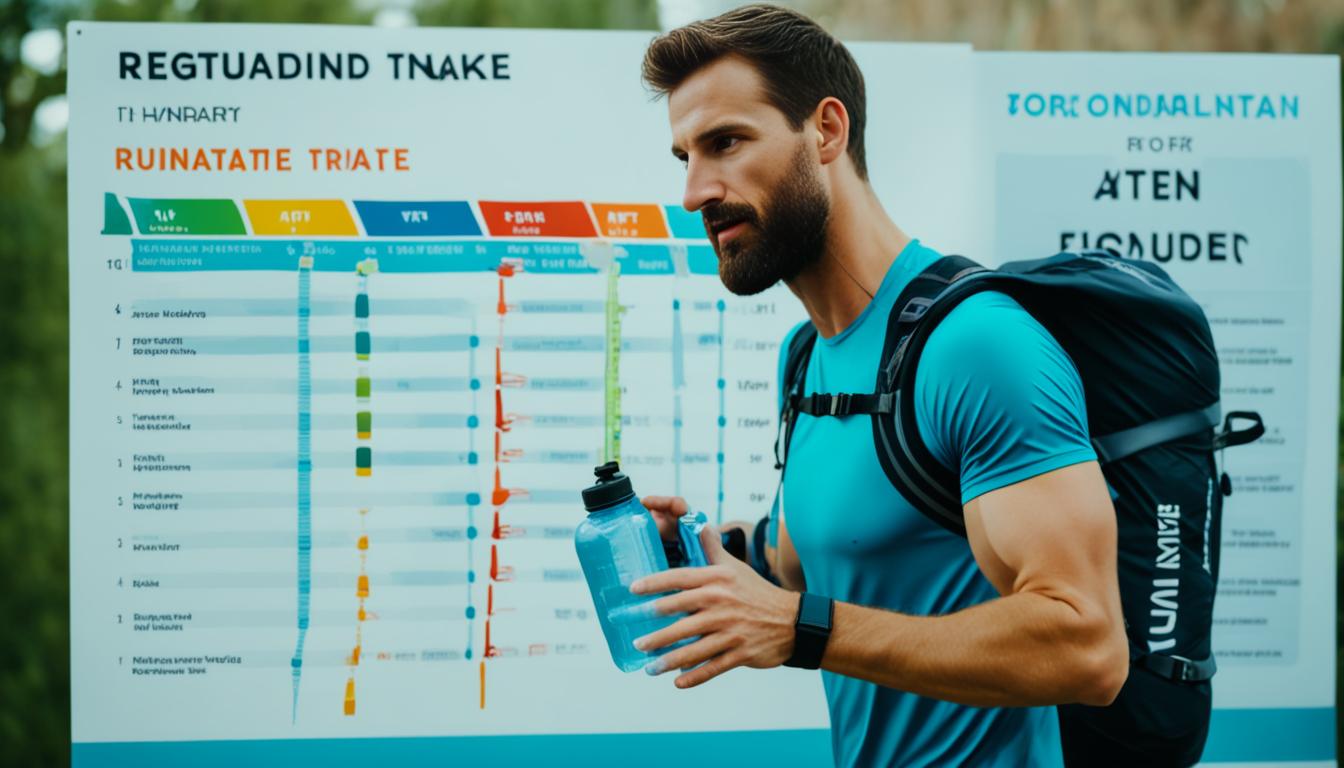Did you know that as little as 2% loss in body water can lead to a significant decrease in performance for runners? Mastering running hydration tips is not only about quenching thirst—it’s a critical component of a runner’s health and performance. Proper hydration for runners involves a dynamic interplay of timing, quantity, and electrolyte balance, and each phase of the run demands its strategy. Whether you are training for a marathon or just enjoy casual jogs, effective hydration techniques for athletes can be the difference between hitting that personal best or hitting the wall.
In the coming sections, we’ll dive into the specifics of how to integrate these hydration strategies into your running routine, setting you up to improve your endurance, recovery, and overall running experience. Stay tuned to turn water into your secret performance booster.
The Importance of Staying Hydrated for Runners
When it comes to long-distance running or even short, intense jogs, maintaining optimal hydration isn’t just a suggestion—it’s an essential part of the routine. The act of hydrating for running goes beyond quenching thirst; it plays a crucial role in ensuring that runners can continue to push their limits without compromising their health and performance. Developing a robust runners hydration plan is as vital to training as the miles themselves.
You Can’t Outrun Dehydration: Understanding the Risks
It’s a simple truth that cannot be overstated: dehydration is a runner’s adversary. Failing to stay hydrated while running can not only lead to decreased performance, but it also carries significant health risks. Ranging from mild symptoms like headaches to severe consequences like heatstroke, the gamut of dehydration’s impact is wide and potentially dangerous, underscoring the necessity for an effective hydration strategy.
Hydration and Thermoregulation: Keeping Cool Under Pressure
The interaction between hydration and the body’s ability to regulate temperature is a delicate dance. As body heat increases, sweating naturally cools the body down, but this also results in fluid loss. Sufficient fluid intake is thus essential to maintain this cooling process, preventing the possible peril of overheating and ensuring that runners can weather the physical stress of their sport.
From Cognitive Function to Joint Health: Hydration’s Role
Staying hydrated supports more than just physical endurance—it also plays a pivotal role in cognitive function and joint health. The mental clarity needed to stay focused and make quick decisions on the track hinges on adequate hydration. Moreover, the lubrication of joints, essential in providing smooth, pain-free movement, is heavily dependent on fluid levels within the body, emphasizing the broader implications of hydration beyond performance.
- Hydrating for running is about striking a balance between too little and too much.
- Staying hydrated while running helps mitigate a host of risks and allows the body’s systems to function harmoniously.
- A sound runners hydration plan encompasses not just water, but electrolytes to replenish what’s lost in sweat.
By adopting a proactive approach to hydration, runners can ensure that they’re not just avoiding the risks of dehydration, but actively enhancing their running experience.
Hydrating for Running: Tailoring Your Strategy
Understanding that hydration is not one-size-fits-all is essential for runners aspiring to perform at their peak. Best practices for runner hydration prescribe tailoring water intake to fit individual needs and circumstances. This personalized approach ensures that runners can maintain optimal performance and health throughout their training and competitions.
Factors such as the duration and intensity of the run, environmental conditions, personal sweat rates, and even the runner’s size and physiology greatly influence hydration requirements. Therefore, running water intake guidance varies, and it’s vital for runners to listen to their bodies and adapt accordingly.

Starting with proper pre-run hydration, it’s critical to enter a run well-hydrated to stave off early fatigue and overheating. This doesn’t mean drinking excessive amounts of water right before a run, but rather ensuring consistent hydration throughout the day leading up to it.
Every run is unique, and so is the body’s response to exercise. A runner’s in-run hydration strategy should therefore flex with the interplay of pace, climate, and their physiological cues.
- Indoor environments typically require less hydration compared to outdoor settings with higher temperature and humidity levels.
- Shorter, less intense runs may only necessitate water, while longer, strenuous efforts can benefit from the addition of electrolytes.
- Monitoring urine color and frequency can serve as a practical hydration barometer throughout the day.
| Run Type | Hydration Focus | Additional Considerations |
|---|---|---|
| Short, Low-Intensity | Water | Pre-hydration with emphasis on previous day intake |
| Long, High-Intensity | Water + Electrolytes | Consistent sips, avoid gulping to prevent stomach discomfort |
| Endurance Events | Energy Drinks + Water | Include carbohydrates for sustained energy; monitor for overhydration |
| Hot and Humid Conditions | Sports Drinks with Electrolytes | Adjust intake based on sweat loss |
Finally, remember that hydration is not solely about what you consume while on the move. It’s a day-long, continuous cycle that requires attention before, during, and after runs to maintain fluid balance and support recovery, ultimately enhancing your running experience.
Starting Off Right: Pre-Run Hydration Techniques
Embarking on a run with optimal hydration levels can define the difference between a record-breaking sprint and an exhaustive jog. Understanding the intricacies of running hydration tips is paramount, and it starts long before the run itself. As you prime your body for the physical activity ahead, engage in hydration strategies that enhance your endurance and prevent the common pitfalls of dehydration.
Optimal Water Intake Before a Run
Consistent water consumption is essential throughout the day, not just the hours leading up to a run. Turn the aim for a pale yellow urine – a telltale sign of proper hydration – into a daily quest. This simple, visual cue helps ensure you’re on the right track before you lace up your running shoes. Before embarking on your run, consider increasing your fluid intake slightly to top off your body’s water stores.
The Role of Electrolytes in Pre-Run Hydration
Electrolytes are the unsung heroes of successful running stories. They regulate nerve and muscle function, hydrate the body, balance blood acidity and pressure, and help rebuild damaged tissue. Before you head out, fortify your hydration strategy with a focus on electrolyte balance. While water is vital, electrolytes like sodium bear importance akin to a co-pilot in managing your body’s hydration levels.
Using sports drinks, electrolyte-infused waters, or natural foods high in sodium, such as salted nuts, can provide a pre-run boost. These sources cater to your body’s need for a proper balance of fluids and electrolytes, setting a foundation for optimal performance and endurance. To encapsulate these essentials of hydration readiness, here’s a simple guideline:
| Hydration Element | Importance | Source |
|---|---|---|
| Water | Essential for basic cellular function and cooling | Water bottles, tap water, filtration systems |
| Sodium | Helps retain fluids and prevent hyponatremia | Sports drinks, salted snacks |
| Potassium | Sustains electrical gradients in the body | Bananas, orange juice, potatoes |
| Magnesium | Supports muscle and nerve function | Nuts, seeds, leafy greens |
The strategies you adopt for hydration weave the tapestry of your running experience. Thoughtfully incorporate these Hydration Strategies Before, During, and After Runs to uplift your routine and elevate your performance.
Running Water Intake Guidance: How Much to Drink During Your Run
Embarking on a run, whether it’s a serene jog or an intense marathon, demands not just perseverance but also the proper hydration for runners. Achieving the delicate equilibrium of fluid intake is essential to keep your body at optimum performance without succumbing to overhydration. This balance — that elusive sweet spot — can be your greatest ally.
The Balancing Act: Hydration Without Overhydration
Overhydration or hyponatremia occurs when the intake of fluids exceeds the body’s ability to expel it, leading to an imbalance of sodium levels. It’s a risky condition that every runner wants to avoid. The question that often plagues runners is, how much water should one drink when embarking on a run? The answer, while not one-size-fits-all, typically ranges from 50ml to 750ml per hour, a spectrum that takes into account the many variables affecting individual hydration requirements.

Monitoring your personal hydration needs can be as scientific as taking a sweat test to gauge your unique fluid loss, or as simple as paying attention to your thirst. Both methods can provide valuable running water intake guidance tailored to you. Here’s a succinct rundown to help you personalize your fluid strategy:
- Assess the conditions: temperature and humidity can alter your hydration dynamics.
- Understand your body: every runner has distinct hydrating needs and sweat rates.
- Periodically check for signs of dehydration.
- Consider the length and intensity of your run: longer runs may require electrolyte supplementation.
Personalizing Your In-Run Hydration: Signs of Dehydration to Watch For
As you navigate through the miles, keeping an eye on key dehydration symptoms is imperative. Persistent dry mouth, an uncharacteristic dip in performance, muscle cramps, and a dramatic change to darker urine are clear signals that your body requires more fluids. These symptoms often serve as immediate running hydration tips, nudging you to gradually increase your water or sports drink intake.
For those runs extending beyond an hour, reaching for electrolyte-rich sports drinks can be particularly advantageous. These specialized beverages are crafted not only to quench your thirst but also to replenish the sodium and other minerals that vanish with your sweat. By embracing these elements of running water intake guidance, you can properly hydrate for runners, enhancing your endurance and safeguarding your health.
Post-Run Recovery: Rehydrating After the Finish Line
Recovery is just as important as the run itself. The key to optimal post-run recovery is effective rehydration, which can make the difference between feeling replenished or being sidelined by dehydration. By embracing the best practices for runner hydration, you can bounce back faster and more efficiently after crossing the finish line. Your body has worked hard; now it’s time to reward it with the essential hydration it craves.
One of the reliable running hydration tips for post-run is to weigh yourself before and after your run. This simple step gives you a clear indication of how much fluid you’ve lost and how much you need to replenish. Following this, you can craft an individualized hydration plan that caters exactly to your body’s requirements. Remember, it’s not just about drinking water; replenishing electrolytes is equally crucial to restore the delicate balance within your body. Here’s a guide to help you rehydrate effectively:
- Start drinking fluids soon after you stop running; the first hour post-run is critical.
- Choose beverages that provide hydration and electrolyte replacement.
- Continue drinking water and electrolyte solutions throughout the rest of the day.
Let’s take a closer look at how much fluid intake is recommended after a run:
| Weight Loss (lbs) | Fluids to Replenish (oz) |
|---|---|
| 1 lb | 16 oz |
| 2 lbs | 32 oz |
| 3 lbs | 48 oz |
| 4 lbs | 64 oz |
| 5 lbs | 80 oz |
Should you find yourself dehydrated post-run, remember not to panic. Dehydration is typically temporary, and with the above steps, you can quickly steer back to a state of healthy fluid balance. Integrate these running hydration tips into your post-run routine and make them as much a part of your training as the miles you log. Healthy hydration habits can empower you to reach new peaks in your running journey.
How Understanding Your Body Can Enhance Hydration

Embarking on the journey of running comes with the necessity to understand and respond to your body’s unique signals. Mastering hydration strategies before, during, and after runs not only elevates your performance but also safeguards your health. This requires an acknowledgement of the individuality in each athlete’s hydration needs, and the employment of informed hydration techniques for athletes that resonate with personal physiological cues.
Assessing Personal Sweat Rate for Better Hydration
To fine-tune your personal hydration strategy, start by evaluating your sweat rate; a key indicator of fluid loss. Calculating this rate can be as simple as weighing yourself before and after your runs. The weight lost is the fluid amount your body demands to replenish. With this insight, you can craft a tailored hydration approach that aligns perfectly with your body’s requirements, thereby optimizing your runs and recovery.
Using Thirst and Urine Color as Hydration Indicators
Heeding the natural signals your body offers, such as thirst and the color of your urine, can be a reliable guide to your hydration status. A thirst mechanism alerts you to drink, while the color of your urine serves as a direct measure of your hydration levels. Typically, a light or pale straw tint in your urine indicates adequate hydration. Conversely, if it’s a deeper yellow or amber, this is a bold sign from your body to increase fluid intake.
Incorporating these simple yet powerful techniques can vastly improve your hydration management. By acknowledging your body’s feedback, you can customize your hydration plan, ensuring that you stay adequately hydrated, yielding better outcomes and instilling confidence in your running endeavors.
Hydration Strategies Before, During, and After Runs
In an athlete’s world where every second and every stride counts, understanding the importance of staying hydrated can make the difference between success and struggle. Developing hydration strategies before, during, and after runs is more than just quenching your thirst; it’s about refining a hydration regimen that factors in the individual stamina, endurance, and recovery phases for runners at all levels.
For instance, before setting out on a marathon of miles, laying the groundwork with a solid pre-run hydration protocol prepares your body for the exertion ahead. This means consuming the right amount of fluids throughout the day, not just in the immediate hour before the run. As you slip on your sneakers and set your playlist, your body should be starting at a hydrative baseline that is both comfortable and enriching for the muscles.
Durng your run, it’s not just about how much water you sip, but when and how you take it. Sip strategy and timing are essential, as you’ll want to avoid gulping large quantities that may lead to discomfort or even diluted performance. Moderate, consistent intake tailored to your body’s signals ensures that your cells remain saturated enough to maintain peak form.
- Drink small amounts at regular intervals
- Use hydration vests or belts for easy access
- Electrolyte-enhanced drinks for extended sessions
And finally, after you’ve dashed across your finish line or wound down your regular route, it’s time to replenish what you’ve lost. Running hydration tips often emphasize immediate recovery, but ensuring that your body gradually rehydrates over the ensuing hours is crucial for muscle and overall physiological repair.
Remember: Your post-run might end on the trail, but your hydration strategy doesn’t finish until you’ve fully replenished your resources.
Implementing these comprehensive hydration strategies before, during, and after runs can uplift your running experience, turning hydration from an afterthought to a cornerstone of your athletic lifestyle.
In the pursuit of personalized hydration perfection, every runner’s journey is different, yet the core principles remain the same. Listen to your body, respect your limits, and keep your cells as eager for the next run as you are.
Electrolytes and Running: More Than Just Sodium
Understanding the full spectrum of electrolytes and their impact on physical performance is crucial for runners seeking to maintain hydration and prevent electrolyte imbalances. As running intensifies, so does the need for a well-rounded electrolyte replenishment strategy. Here, we delve into the roles of key electrolytes and provide guidance on selecting sports drinks to optimize your running hydration tips.
Choosing the Right Types of Sports Drinks
When it comes to selecting sports drinks, runners need to consider not only taste preferences but also the drink’s functional properties. The aim is to replenish fluids while also supplying the right balance of electrolytes lost during strenuous exercise. The choice between isotonic, hypotonic, and hypertonic drinks can make a significant difference in terms of rapid rehydration and energy continuation.
- Isotonic Drinks: Deliver fluids and electrolytes in a balance similar to the human body, making them ideal for general rehydration.
- Hypotonic Drinks: Contain fewer carbohydrates and are lighter in electrolytes, best suited for quick rehydration without the excess energy.
- Hypertonic Drinks: Packed with carbohydrates, these are designed for recovery, refueling the body post-run.

| Drink Type | Primary Purpose | Electrolyte Content | Usage |
|---|---|---|---|
| Isotonic | Hydration and Energy | Medium | During Exercise |
| Hypotonic | Rapid Hydration | Low | Shorter Activities |
| Hypertonic | Energy and Recovery | High | Post Exercise |
Navigating Through Electrolyte Imbalances
Runners navigating electrolytes and running must be alert to the signs of imbalance, which may include muscle cramping, fatigue, and dizziness. To combat these challenges, integrate a variety of food sources rich in electrolytes such as bananas, dairy, leafy greens, and nuts into your diet. Additionally, choosing the right types of sports drinks for your workout needs can seamlessly supplement your body’s electrolyte demands.
Remember, an effective running hydration strategy requires more than just water; it requires a tactical approach to maintaining the electrolytes that support your endurance and vitality.
Staying Hydrated While Running in Different Climates
Understanding how diverse climates impact hydration is crucial for runners. Whether braving the scorching sun or enduring the crisp winter air, athletes must modify their hydration tactics to maintain performance. Staying hydrated while running in different climates not only optimizes physical capabilities but also ensures overall well-being during training or competition.
Hydration Strategies for Hot and Humid Conditions
In the face of high temperatures and steamy conditions, sweat does not evaporate as effectively, leaving runners feeling more dehydrated. It’s imperative to focus on drinks that replace fluids and electrolytes at a higher rate. Here are some running hydration tips for when the mercury rises:
- Pre-hydrate with additional fluids, and consider consuming a sports drink to preload electrolytes.
- Increase the frequency of hydration breaks, and drink fluids with a higher content of sodium and potassium.
- Wear breathable clothing to aid in the evaporation of sweat and mitigate excessive fluid loss.
Adapting Hydration Techniques for Cold Weather Runs
Conversely, colder climates can be misleading, as the body’s thirst response diminishes and sweat evaporates more rapidly. These factors can lead to reduced fluid intake, hence increasing the risk of dehydration. Implement these adapted strategies to stay well-hydrated in wintry conditions:
- Set reminders to drink, since you might not feel as thirsty as you would in a warmer environment.
- Use insulated water bottles to prevent freezing and encourage regular fluid consumption.
- Even during cold runs, wear layers that allow for adjustment based on your body heat and sweat rates.
| Climate Condition | Hydration Challenge | Strategy |
|---|---|---|
| Hot and Humid | Reduced sweat evaporation | Increased electrolyte intake |
| Cold | Decreased thirst response | Regular fluid intake reminders |
| Variable (e.g., indoors vs. outdoors) | Diverse humidity and temperatures | Flexible hydration plans based on environment and exertion levels |
Conclusion
In the dynamic world of running, the significance of proper hydration for runners cannot be overstressed. It is the springboard that can catapult athletes to stellar performance and swift recovery. Effective hydration transcends mere fluid intake; it’s about understanding the unique fabric of our bodies and the diverse environments they adapt to, a concept paramount to endurance sports.
- Hydration strategies before, during, and after runs form the cornerstone of a runner’s routine. These strategies must be as dynamic as the runs themselves, changing as swiftly as the terrain beneath your feet.
- Tailoring hydration to individual needs implies that the pre-run glass of water is just the beginning of a nuanced, often changing hydration narrative.
- In-run hydration tactics pivot sharply on the intensity of your journey and the thirst cues your body broadcasts.
- And after the finish line, recovery hydration ventures restore balance, setting the stage for the next day’s conquest.
Engaging with best practices for runner hydration resonates with the ambition of any athlete: to run faster, farther, and more fiercely than before. Infusing these practices into your regimen ensures that every run is empowered, not impeded by hydration levels.
“Mastering hydration is not just a runner’s task, it is their art. It is about listening to, adapting to, and respecting the needs of your body in pursuit of your running ambitions.”
To navigate these hydration channels properly, runners are encouraged to foster a holistic approach. Recognize the signs of dehydration but also the subtle hints your body may give you about overhydration. Adopt an amalgam of methods, brewing a personalized concoction of water and electrolytes that your runs will thank you for.
The journey of a thousand miles begins with a single step, and a runner’s quest for excellence starts with a sip of water. Embrace these insights and weave them into your training tapestry. Through the ebb and flow of rigorous training, your devotion to proper hydration stands as your silent powerhouse, fuelling your strides towards the horizons of your utmost potential.
[Reserved for additional information or section as required by editorial guidelines]
Embarking on the journey of running necessitates more than just physical endurance and mental fortitude; it calls for a holistic approach to hydration that interweaves the science of fluid balance with the art of listening to your body. Understanding the intricate play between hydration and health can lead to transformative experiences on the pavement or the trail. Embracing the insights gathered from meticulous research and expert advice, runners across the United States are finding that their best ally in achieving peak performance is their own tailored hydration strategy—finely tuned to their individual needs and the caprices of the climates they conquer.
Whether treading through the humid streets of Miami or the arid paths of Phoenix, hydration stands as a testament to the runner’s dedication to their craft. Echoing through the various strategies discussed, from pre-run preparedness to post-run replenishment, is a foundational truth: staying hydrated is an investment in your running future. Mastery of this dynamic aspect of running places you at the starting line of each run with a tank full of potential and a body primed for the road ahead.
In summary, we’ve traversed the spectrum of hydration’s role in a runner’s life, discerning that it’s as crucial as the shoes on your feet or the path beneath them. As you lace up for your next run, remember that hydration is your silent partner in every step. Let the unwavering commitment to maintaining proper hydration be the fuel that propels you forward, guiding you towards personal records and new horizons in your running journey—because every drop counts on the road to greatness.

